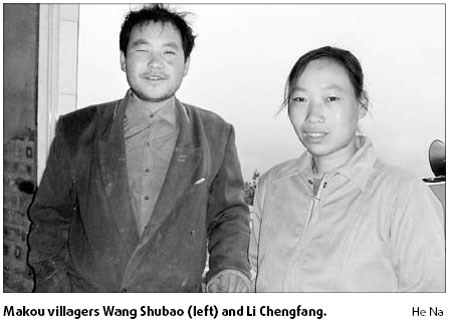
|
CHINA> Post-quake Life
 |
|
The house of hope Wang and Li built
By He Na (China Daily)
Updated: 2009-05-25 10:45 Though it is raining outside and the weather is a little cold, Wang Shubao and Li Chengfang, of Makou village, one of the quake-hit areas in Sichuan province, are reluctant to drop their spades.
 They are mixing cement with fine sand to plaster the inside walls of the house behind them - a two-storied steel and cement structure with a usable floor space of at least 90 sq m. "The new house is much better than our old one, which was completely destroyed in last year's earthquake," says Li Chengfang, pointing to some debris. Their 11-year-old son Wang Lin is waving to them through a window on the second floor. "My son is looking forward to moving into the new house and has even decided how he will decorate his room," she adds. "If we work harder, we can move out of the temporary house and live in our new home at end of this month," says the 35-year-old woman with a smile on her face. However, at this time last year, their lives were filled with sorrow. Lying on the southwest corner of Guangyuan city, Makou village is one of the poorest in the province and just a few kilometers from the hard hit Beichuan county.
However after one year, the village presents a totally different picture. A new cement road reaches as far as the village, most of the houses have been rebuilt and classes at the new school are set to begin in September. Zuo Jiayou, Party secretary of Sandui county, says the success in Makou village owes as much to the support of the central government and donations from the society as well as the efforts of the villagers. Last July the villagers established a group to lead the reconstruction work, comprising four teams - construction, purchase, finance and general supervision. All expenditures are closely supervised open to scrutiny by the villagers once a month. The village also made the restoration of livelihoods a priority. Wang Bilie, 54, lost her grandson and daughter-in-law in the quake, and was left with no source of income. The village not only repaired her house, but also helped her to find a way to make a living. Wang says she could have never have dreamt of the changes in her village after the disaster. Neither did members from the State Council Leading Group Office of Poverty Alleviation and Development (LGOP) and the United Nations Development Program (UNDP), who provided the technical and financial support for the reconstruction of the village. Makou is among the first batch of 19 experimental villages chosen by the LGOP and UNDP for their reconstruction program. Xu Hui, director of the planning department of the LGOP says the experience gained in Makou will be used to rebuild the more than 4,800 poorest villages struck by the disaster across Sichuan, Gansu and Shaanxi. The program has so far poured 1.2 million yuan into the village. Subinay Nandy, country director of UNDP China, says he is very satisfied with the progress the village has made. The reconstruction program that started last September, will last two years. Its total funding stands at $5.36 million, which includes approximately $1.65 million contributed by the Canadian government. |